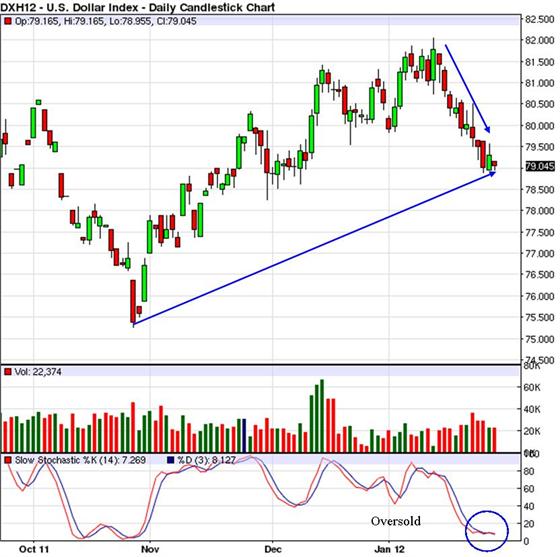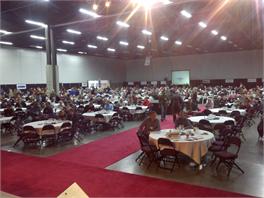 Hello Reader
Hello Reader
I spent 4 days last week at FarmTech in Edmonton at the new Northlands venue. The show was a huge success and it was great to catch up with so many of you. I must thank my fellow Nuffield Scholar, James Peck, for his excellent keynote on Thursday in front of 1,400 people. I never told him how many people he’d be speaking to until he stepped off the plane. Once the color returned to his face, he nailed it and did a fantastic job! Can you imagine farming 5,300 acres in England, 47 acres at a time?
In this week’s newsletter, we’ll look at an interesting land rental agreement that has a great fit for a cash-strapped farm or young farmers looking to expand. Next, we’ll discuss the use of side-dressing nitrogen in our CTF system. Last, I’ll comment on a recent email through my inbox on the use of strip-till vacuum planters in canola. We’ll finish with technical grain market news.
Have a great week.

A land rental agreement idea from the UK
Expanding when capital is short
James Peck, a young farmer near Cambridge, England, shared an interesting land rental agreement that has allowed him to expand his farm by 380% since 2007. Land costs in his area, about one hour NE of London, are $12,000 an acre and competition for farm land is high, much like it is here. James found a way to expand his land base by reducing up-front capital costs, minimizing financial risk and increasing cash flow by offering an attractive land rental arrangement to his land lords. Here is how it works in a nutshell:
The land lord pays a custom rate to the tenant for seeding, spraying and harvesting the crop as well as all the variable input costs (seed/fertilizer/herbicide/fungicide). The tenant pays the landlord a fixed rent and the profits are split 50-50. The custom seeding, spraying and harvesting costs are broken down into monthly payments paid by the landlord to the tenant.
Benefits:
• The landlord maintains farmer status and enjoys significant tax breaks versus a straight cash renter.
• The landlord receives land rent plus 50% of the profits earned each year.
• The tenant receives monthly payments for custom work which creates cash flow.
• The tenant receives only 50% of the profits but is risking 50% or less of the costs.
• The tenant always has enough cash flow to cover his machinery costs.
This rental agreement is brilliant for the young, cash stricken farmer who wants to expand but can’t access the capital to do so. It also reduces the financial risk because if things go south and profits are negative, you’ve agreed to be paid for custom farming the land. You’ll always be able to cover your fixed costs of machinery if you set up your custom rates correctly. The upside may be considered limiting with a 50-50 revenue split but it’s proportional to the amount invested. You could earn 100% of the profits but you’re risking 100% of the capital in a straight cash rent deal.
Let’s run through a quick example.
Landlord pays
Seed: $45.00/ac canola
Fertilizer: $90.00/ac
Chemical: $25.00/ac
Custom: $55.00/ac
Total costs: $215.00
Rental income: $70.00/ac
Yield: 40 bu/ac × $10.00/bu = $400.00/ac
In this scenario, the landlord would receive $215 an acres to cover his variable costs plus $70 rent from the gross revenue. The profit margin would be $185 an acre ($400.00 - $215.00) which is split 50-50 for a total of $92.50 each. The tenant benefits from steady cash flow and reduced capital requirements while the landlord receives fair rent plus the upside of 50% of profits. You could tweak this agreement anyway you like and make it fit.
Thank you, James, for sharing this innovative and proven idea for farm expansion. SL
Side dressing nitrogen a viable option
One of the goals in our controlled traffic farming system is to side dress NH3 nitrogen in wheat, barley and canola with coulters. Our equipment set-up allows us to move in between the stubble very accurately which gives us the option of side dressing with minimal crop disturbance. We know that a well-timed split application of nitrogen can improve yield, protein, reduce lodging and spread out risk. However, today’s methods rely on broadcast urea or dribble banding UAN, two very inefficient practices of applying nitrogen.
I came across Dave Mengel from Kansas State University who is researching side dress applications of NH3 using coulters versus broadcast urea in winter wheat. Dave is applying between 30 and 120 lbs/ac of nitrogen with NH3 using JD coulters on 15-inch and 20-inch row spacing in winter wheat planted on 7.5-inch row spacing. These are the preliminary findings of his research:
• Soil conditions need to be right to get a good seal after the coulter runs through to avoid NH3 gassing off.
• Without a good soil seal, the ammonia gasses off and crop foliage is damaged by high rates of nitrogen.
• There was no foliar damage at the lower rate of 30 lbs/N/ac.
• Foliar damage was severe at 90 lbs/N and 120 lbs/N/ac.
• There was a 2.2 bu/ac difference that favored broadcast urea due to the crop damage caused by coulters running on top of the rows.
I corresponded with Dave over email and he felt that in drier climates like ours and 12-inch row spacing, it would be possible to run the coulters between every other row using RTK and auto steer. This would eliminate crop damage from the coulters running directly on the row. In our situation, the only limitation would be the height of the hitch on the Steiger which is 16 inches. We could travel in-crop up to flag leaf without crop damage.
Watch this YouTube video for Dave’s comments on side dressing nitrogen in wheat.
I prefer to use NH3 is because it is a) less expensive than other sources of nitrogen, b) is ammonical nitrogen which means it is immediately plant available, and c) is 82% nitrogen versus UAN which is only 28% which means more acres per fill. The reason I don’t prefer UAN in a side dress application is because it is only 50% available initially. UAN is 25% nitrate that encourages vegetative growth and not reproductive growth, 25% is ammonium which is plant available, and the remaining 50% is urea which requires two conversions before it becomes plant available.
This is the plan for our system. We would put a MaxQuip high pressure NH3 system with a frame mounted 1,000 gal NH3 tank on the top of a 30-foot Frigstad air seeder with 12-inch row spacing. I’d use the MaxQuip NH3 system so I can get down to 30 lbs of N/ac and maintain accuracy. We would upgrade to Field IQ with our current Trimble FMX monitor to control the MaxQuip NH3 system. We have RTK and have successfully set up an inter-row seeding system with hitch modifications on our drill already. We would do the same hitch modifications on the Frigstad to move inter-row. I estimate the cost of the 1,000 gallon frame mounted tank, MaxQuip system and plumbing to be roughly $22,000 installed on a 30 ft toolbar. The field IQ is an additional $2,000. I’d like to find used Bourgault mid-row banders which retail brand new for about $1,215 per shank. I may find a deal on Yetter, Dawn or even John Deere or Case IH. The total cost for the set up should be approximately $38,800.
To kick it up a notch and for an additional $20,000 we could mount an OptRx or a GreenSeeker and variable rate our side dress nitrogen using real time NDVI sensory images. This would allow us to apply inter-row, variable rate nitrogen on the go which would really boost our efficiency by placing nitrogen in the right place. That, like many things, will remain in the idea warehouse for now but I really see the value in it.
So, let’s do a little Steve’s quick math on this crazy idea:
$38,800 NH3 kit ÷ 640 ac = $60.00/ac
We would need to generate an additional $60.00 an acre to pay for this side dress nitrogen set up the first year. If we were to amortize this cost over three years, there’s no doubt we could start generating a return greater than $20.00 ac in yield, protein and harvest efficiency from reduced lodging. It may seem far-fetched to some but my ambition is to intensify and do more with less land base. CTF, inter-row, side dress nitrogen, liquid injection in-furrow, inter-row cultivation, shroud spraying, disk openers, strip till, vacuum planters, on-row fungicide spraying, and inter-row herbicide spraying are all on my radar for intensifying production. Three systems down, eight more to go. That is if I don’t find something else in the mean time. SL
Source: Low disturbance NH3 openers
Strip till canola planter system
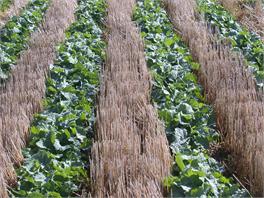 I wanted to give you a look at what the canola emergence looks like in a strip till-canola planter system. This is winter canola in Kansas where they use vacuum planters and strip till in corn and soybeans. They seed canola with a planter because it’s a tool they already have much like we seed canola with air drills because it’s a tool we already have. They also use strip till to manage residue and place fertilizer.
I wanted to give you a look at what the canola emergence looks like in a strip till-canola planter system. This is winter canola in Kansas where they use vacuum planters and strip till in corn and soybeans. They seed canola with a planter because it’s a tool they already have much like we seed canola with air drills because it’s a tool we already have. They also use strip till to manage residue and place fertilizer.
The photo you see here is winter canola planted into strip tilled winter wheat residue on 20-inch rows. You can see the 8-inch wide strip till bands with canola branching out at an early age. The winter wheat stubble is dense and would be a challenge for our air drills in a direct seeding system. The strip till system in canola works well to manage residue and warm the soil while keeping enough standing stubble to reduce evaporation and wind speed.
The question is how wide can we go with row spacing? We don’t have any recent or relevant row spacing research trials to go by. A few Beyond Agronomy News subscribers have planted canola on 15-inch, 20-inch, 24-inch and 30-inch row spacing but only one with a vacuum planter at 15-inch and 30-inch rows. There was a slight yield drag from 15 to 30 inches in 2010. The nearest US research is from Washington on winter canola and shows no yield drag up to 24-inch rows.
The strip till-vacuum planter system in canola works and the 50% reduction in seed costs may be just the catalyst for people to shift to this system. In the words of Liberal leader Michael Ignatieff, “We can do bedder!” What you think? Email me your thoughts on this system. SL
Photo source: Brian Caldbeck
Pictured above: Canola planted into strip tilled winter wheat stubble.
Market News
Technicals
Canola Nov12: The long term trend is down and the short term trend is up.
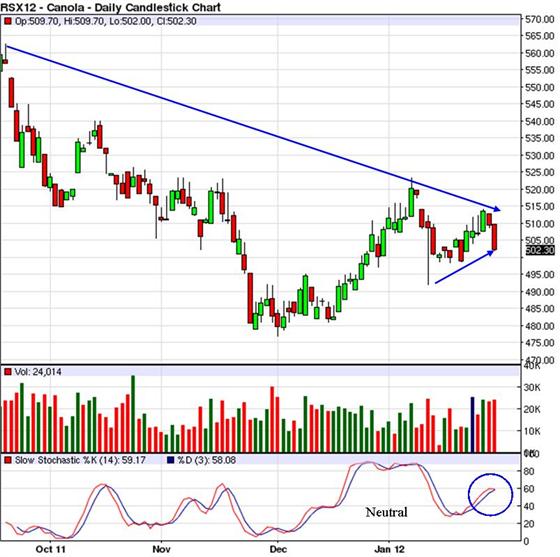
Wheat Dec12: The long term trend is down and the short term trend is up.
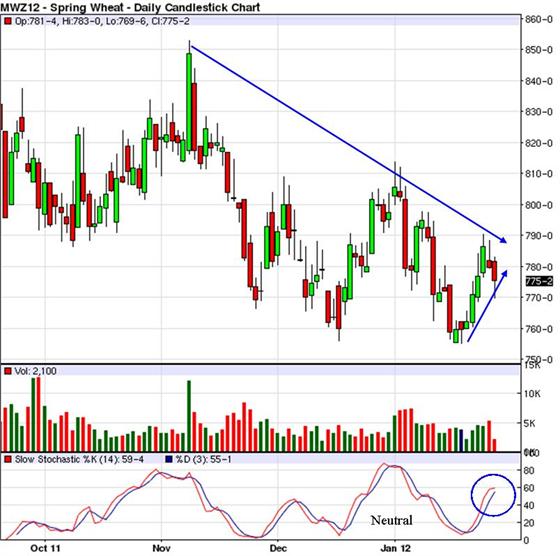
Corn Dec 12: The long term trend is down and the short term trend is up.
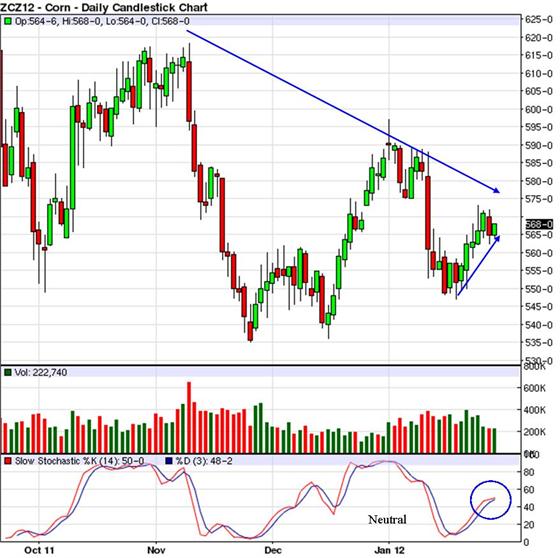
Soybeans Nov12: The long term trend is down and the short term trend is up.
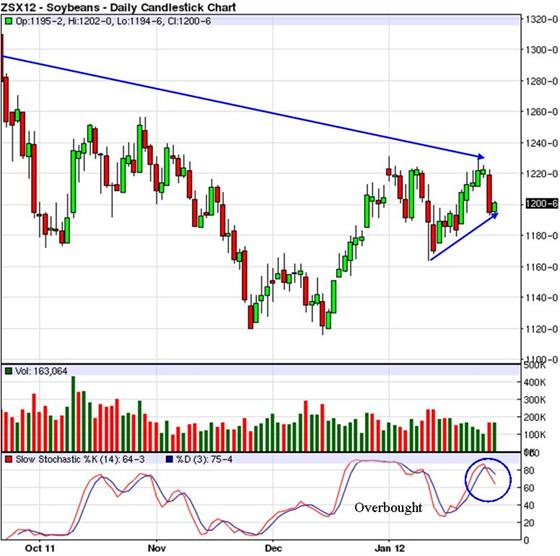
CDN$ Feb12: The long term trend is neutral while the short term trend is up.
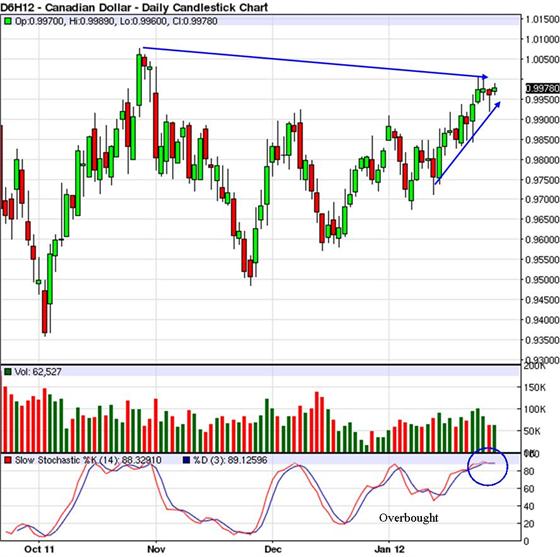
USD Feb12: The long term trend is up and the short term trend is down.
